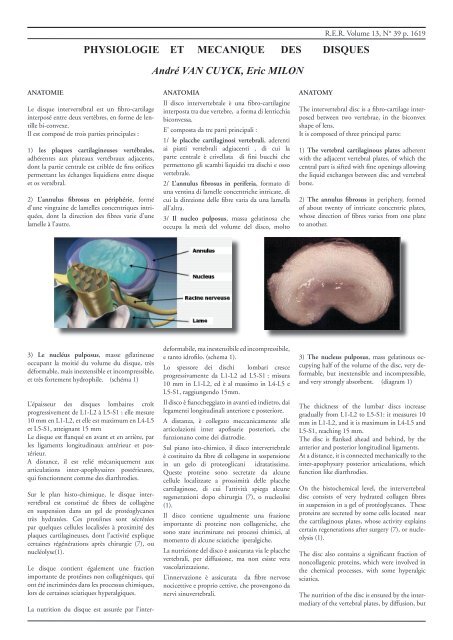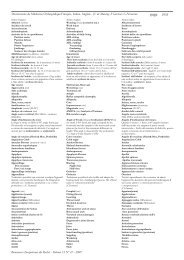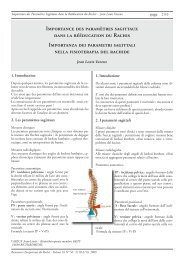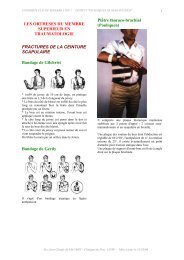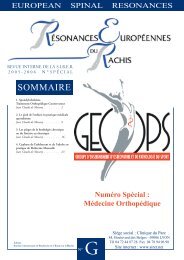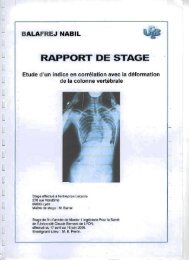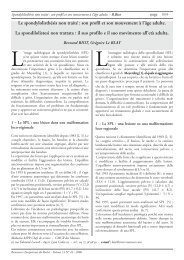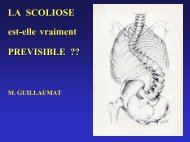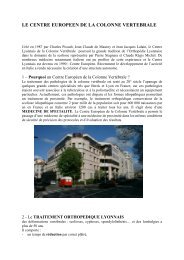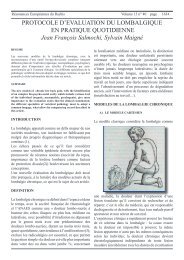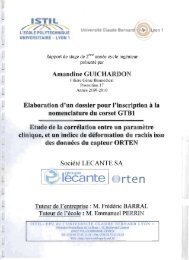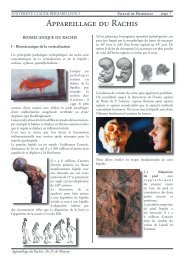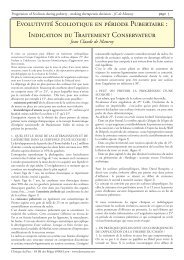PHYSIOLOGIE ET MECANIQUE DES DISQUES André VAN CUYCK ...
PHYSIOLOGIE ET MECANIQUE DES DISQUES André VAN CUYCK ...
PHYSIOLOGIE ET MECANIQUE DES DISQUES André VAN CUYCK ...
Create successful ePaper yourself
Turn your PDF publications into a flip-book with our unique Google optimized e-Paper software.
<strong>PHYSIOLOGIE</strong> <strong>ET</strong> <strong>MECANIQUE</strong> <strong>DES</strong> <strong>DISQUES</strong><br />
André <strong>VAN</strong> <strong>CUYCK</strong>, Eric MILON<br />
R.E.R. Volume 13, N° 39 p. 1619<br />
ANATOMIE<br />
Le disque intervertébral est un fibro-cartilage<br />
interposé entre deux vertèbres, en forme de lentille<br />
bi-convexe.<br />
Il est composé de trois parties principales :<br />
1) les plaques cartilagineuses vertébrales,<br />
adhérentes aux plateaux vertébraux adjacents,<br />
dont la partie centrale est criblée de fins orifices<br />
permettant les échanges liquidiens entre disque<br />
et os vertébral.<br />
2) L’annulus fibrosus en périphérie, formé<br />
d’une vingtaine de lamelles concentriques intriquées,<br />
dont la direction des fibres varie d’une<br />
lamelle à l’autre.<br />
ANATOMIA<br />
Il disco intervertebrale è una fibro-cartilagine<br />
interposta tra due vertebre, a forma di lenticchia<br />
biconvessa.<br />
E’ composta da tre parti principali :<br />
1/ le placche cartilaginosi vertebrali, aderenti<br />
ai piatti vertebrali adgiacenti , di cui la<br />
parte centrale è crivellata di fini bucchi che<br />
permettono gli scambi liquidei tra dischi e osso<br />
vertebrale.<br />
2/ L’annulus fibrosus in periferia, formato di<br />
una ventina di lamelle concentriche intricate, di<br />
cui la direzione delle fibre varia da una lamella<br />
all’altra.<br />
3/ Il nucleo pulposus, massa gelatinosa che<br />
occupa la metà del volume del disco, molto<br />
ANATOMY<br />
The intervertebral disc is a fibro-cartilage interposed<br />
between two vertebrae, in the biconvex<br />
shape of lens.<br />
It is composed of three principal parts:<br />
1) The vertebral cartilaginous plates adherent<br />
with the adjacent vertebral plates, of which the<br />
central part is sifted with fine openings allowing<br />
the liquid exchanges between disc and vertebral<br />
bone.<br />
2) The annulus fibrosus in periphery, formed<br />
of about twenty of intricate concentric plates,<br />
whose direction of fibres varies from one plate<br />
to another.<br />
3) Le nucléus pulposus, masse gélatineuse<br />
occupant la moitié du volume du disque, très<br />
déformable, mais inextensible et incompressible,<br />
et très fortement hydrophile. (schéma 1)<br />
L’épaisseur des disques lombaires croît<br />
progressivement de L1-L2 à L5-S1 : elle mesure<br />
10 mm en L1-L2, et elle est maximum en L4-L5<br />
et L5-S1, atteignant 15 mm<br />
Le disque est flanqué en avant et en arrière, par<br />
les ligaments longitudinaux antérieur et postérieur.<br />
A distance, il est relié mécaniquement aux<br />
articulations inter-apophysaires postérieures,<br />
qui fonctionnent comme des diarthrodies.<br />
Sur le plan histo-chimique, le disque intervertébral<br />
est constitué de fibres de collagène<br />
en suspension dans un gel de protéoglycanes<br />
très hydratées. Ces protéines sont sécrétées<br />
par quelques cellules localisées à proximité des<br />
plaques cartilagineuses, dont l’activité explique<br />
certaines régénérations après chirurgie (7), ou<br />
nucléolyse(1).<br />
Le disque contient également une fraction<br />
importante de protéines non collagéniques, qui<br />
ont été incriminées dans les processus chimiques,<br />
lors de certaines sciatiques hyperalgiques.<br />
La nutrition du disque est assurée par l’inter-<br />
deformabile, ma inestensibile ed incompressibile,<br />
e tanto idrofilo. (schema 1).<br />
Lo spessore dei dischi lombari cresce<br />
progressivamente da L1-L2 ad L5-S1 : misura<br />
10 mm in L1-L2, ed è al massimo in L4-L5 e<br />
L5-S1, raggiungendo 15mm.<br />
Il disco è fianccheggiato in avanti ed indietro, dai<br />
legamenti longitudinali anteriore e posteriore.<br />
A distanza, è collegato meccanicamente alle<br />
articolazioni inter apofisarie posteriori, che<br />
funzionano come dei diatrodie.<br />
Sul piano isto-chimico, il disco intervertebrale<br />
è costituito da fibre di collagene in sospensione<br />
in un gelo di proteoglicani idratatissime.<br />
Queste proteine sono secretate da alcune<br />
cellule localizzate a prossimità delle placche<br />
cartilaginose, di cui l’attività spiega alcune<br />
regenerazioni dopo chirurgia (7), o nucleolisi<br />
(1).<br />
Il disco contiene ugualmente una frazione<br />
importante di proteine non collageniche, che<br />
sono state incriminate nei processi chimici, al<br />
momento di alcune sciatiche iperalgiche.<br />
La nutrizione del disco è assicurata via le placche<br />
vertebrali, per diffusione, ma non esiste vera<br />
vascolarizzazione.<br />
L’innervazione è assicurata da fibre nervose<br />
nocicettive e proprio cettive, che provengono da<br />
nervi sinuvertebrali.<br />
3) The nucleus pulposus, mass gelatinous occupying<br />
half of the volume of the disc, very deformable,<br />
but inextensible and incompressible,<br />
and very strongly absorbent. (diagram 1)<br />
The thickness of the lumbar discs increase<br />
gradually from L1-L2 to L5-S1: it measures 10<br />
mm in L1-L2, and it is maximum in L4-L5 and<br />
L5-S1, reaching 15 mm.<br />
The disc is flanked ahead and behind, by the<br />
anterior and posterior longitudinal ligaments.<br />
At a distance, it is connected mechanically to the<br />
inter-apophysary posterior articulations, which<br />
function like diarthrodies.<br />
On the histochemical level, the intervertebral<br />
disc consists of very hydrated collagen fibres<br />
in suspension in a gel of protéoglycanes. These<br />
proteins are secreted by some cells located near<br />
the cartilaginous plates, whose activity explains<br />
certain regenerations after surgery (7), or nucleolysis<br />
(1).<br />
The disc also contains a significant fraction of<br />
noncollagenic proteins, which were involved in<br />
the chemical processes, with some hyperalgic<br />
sciatica.<br />
The nutrition of the disc is ensured by the intermediary<br />
of the vertebral plates, by diffusion, but
R.E.R. Volume 13, N° 39 p. 1620<br />
médiaire des plaques vertébrales, par diffusion,<br />
there is no clean vascularization.<br />
mais il n’y a pas de vascularisation propre.<br />
L’innervation est assurée par des fibres nerveuses<br />
nociceptives, et proprioceptives, provenant des<br />
nerfs sinuvertébraux.<br />
BIO<strong>MECANIQUE</strong><br />
Le rachis lombaire doit à la fois être très stable,<br />
supportant le poids du corps, du tronc, et<br />
également très mobile. Le disque intervertébral<br />
est intégré dans une “unité fonctionnelle<br />
“ (D’ORNANO)(2), comprenant les<br />
articulations postérieures, les moyens d’union<br />
capsulo-ligamentaires, et réalisant un trépied<br />
fonctionnel.<br />
BIOMECCANICA<br />
Il rachide lombare deve essere allo stesso tempo<br />
molto stabile, sopportando il peso del corpo,<br />
del tronco e ugualmente molto mobile. Il<br />
disco intervertebrale è integrato in un’ »unità<br />
funzionale » (d’ORNANO) (2), che comprende<br />
le articolazioni posteriori, i mezzi di unione<br />
capsulo-legamentari e realizzando un treppiede<br />
funzionale.<br />
La mobilità segmentare dei dischi lombari<br />
aumenta progressivamente dall’alto verso il<br />
basso, passando in media da 12° in L1-L2, ai<br />
25° in L4-L5. Il disco L5-S1 è meno mobile.<br />
In piedi, il disco è il seggio di forze di<br />
compressione, mentre le articolari sono il seggio<br />
di uno sforzo di cesoiata.<br />
The innervation is ensured by nociceptive and<br />
proprioceptive nervous fibres, coming from the<br />
sinu-vertebral nerves.<br />
BIOMECANICS<br />
The lumbar spine must at the same time be<br />
very stable, supporting the weight of the body,<br />
the trunk, and also very mobile. The intervertebral<br />
disc is integrated in a “functional unit”<br />
(D’ORNANO)(2), including the posterior<br />
articulations, the capsulo-ligamentar union, and<br />
carrying out a functional tripod.<br />
The segmentary mobility of the lumbar discs<br />
increases from top to bottom gradually, passing<br />
La mobilité segmentaire des disques lombaires<br />
augmente progressivement de haut en bas,<br />
passant en moyenne de 12° en L1-L2 à 25° en<br />
L4-L5.Le disque L5-S1 est moins mobile.<br />
En position debout, le disque est le siège de force<br />
de compression, alors que les articulaires sont le<br />
siège d’un effort de cisaillement.<br />
Les mouvements de flexion et extension se<br />
font autour d’un axe de rotation situé dans le<br />
corps vertébral sous-jacent, grâce au glissement<br />
I movimenti di flessione ed estensione si fanno<br />
attorno ad un’asse di rotazione situato nel corpo<br />
vertebrale sotto, grazie ad un scivolamento<br />
arciforme delle facette articolari.<br />
In flessione, il disco è cuneiforme a base<br />
posteriore, e triangolare in’estensione. Il disco è<br />
sottoposto ad importanti forze di compressione,<br />
ma anche di trazione e di cesoiata : compressione<br />
nella concavità, trazione della convessità.<br />
Le rotazioni assiali impongono dei sforzi di<br />
on average from 12° in L1-L2 to 25° in L4-L5.<br />
Disc L5-S1 is less mobile.<br />
In upright position, the disc is the centre of<br />
compressive force, whereas the articular ones are<br />
the centre of a shearing force.<br />
The movements of inflexion and extension are<br />
done around an axis of rotation located in the<br />
subjacent vertebral body, thanks to the arciform<br />
slip of the articular facets.<br />
In inflexion, the disc is wedge-shaped with posterior<br />
base, and triangular in extension. The disc
arciforme des facettes articulaires.<br />
En flexion, le disque est cunéiforme à base<br />
postérieure, et triangulaire en extension. Le<br />
disque est soumis à d’importantes forces de<br />
compression, mais aussi de traction et de cisaillement<br />
: compression dans la concavité, traction<br />
de la convexité.<br />
Les rotations axiales imposent des efforts de<br />
cisaillement, qui sont très mal tolérées par le<br />
disque, pouvant creer des lésions fissuraires au<br />
niveau de l’annulus, ou désinsérer les plaques<br />
vertébrales.<br />
Le nucléus pulposus transforme les lignes verticales<br />
en forces radiales, déformant l’annulus<br />
fibrosus qui retrouvera ensuite sa forme<br />
initiale. Ces variations de pression favorisent<br />
les échanges liquidiens avec les stuctures osseuses<br />
environnantes : la perte d’eau diurne est<br />
compensée par la réhydratation nocturne du<br />
disque, favorisée par le décubitus.<br />
Couplé aux ligaments longitudinaux, le disque<br />
constitue un système précontraint, se déformant<br />
d’autant moins que la vitesse d’application des<br />
charges est rapide..<br />
Avec le vieillissement, le disque perd sa capacité<br />
hydrophile,se rafermit, se pince, et sa stucture<br />
se rapproche de la composition des plaques<br />
cartilagineuses.<br />
La pression intra-discale est très variable selon la<br />
position : elle est importante en position assise,<br />
tronc penché en avant, et maximum lors du<br />
port de charge, dos non verrouillé. Les travaux<br />
de R.MOTTIER(4), (tableau 1) mesurant<br />
in vivo les pressions discales dans les activités<br />
quotidiennes, ont confirmé en grande partie les<br />
travaux de NACHEMSON(5).<br />
cesoiata, male tollerati dal disco, potendo creare<br />
delle lesioni fissulari al livello dell’annulus, o<br />
disinserire le placche vertebrali.<br />
Il nucleo pulposus trasforma le linee verticali<br />
in forze radiali, deformando l’annulus fibrosus<br />
che ritroverà in seguito la sua forma iniziale<br />
(schema 2). Queste variazioni di pressione<br />
favoriscono gli scambi liquidei con le strutture<br />
ossee circostanti : la perdita di acqua diurna è<br />
compensata dalla reidratazione notturna del<br />
disco, favorizzata dal decubito.<br />
Accoppiato ai legamenti longitudinali, il<br />
disco costituisce un sistema precompresso,<br />
deformandosi tanto meno che la velocità di<br />
applicazione dei carichi è rapida...<br />
Coll’invecchiamento, il disco perde la sua<br />
capacità idrofile, si raffermisce, si pizzica e la<br />
sua struttura si avvicina della composizione delle<br />
placche cartilaginose.<br />
La pressione intra-discale è molto variabile<br />
secondo la posizione : è importante in<br />
posizione seduta, tronco inclinato in avanti,<br />
e massima al momento di sollevare un peso,<br />
dorso non « chiuso ». I lavori di R. MOTTIER<br />
(4), (descrizione 1) misurando in vivo le<br />
pressioni discali nelle attività quotidiane,<br />
hanno confermato in gran’ parte i lavori di<br />
NACHEMSON (5).<br />
L’azione dei muscoli para-vertebrali è bene<br />
conosciuta, fanno parte integrante dell’asse<br />
rachideo, assimilato ad una trave composite.<br />
In posizione di flessione, esiste un reclutamento<br />
progressivo dei muscoli spinali, che diventano<br />
totalmente silenziosi in flessione completa : la<br />
stabilità è allora soltanto assicurata dal disco,<br />
sottoposto a costrizioni di cesoiata, e le articolari<br />
posteriori, seggio di pressioni verticali.<br />
R.E.R. Volume 13, N° 39 p. 1621<br />
is subjected to significant forces of compression,<br />
but also of traction and shearing: compression in<br />
concavity, traction of convexity.<br />
Axial rotations impose shearing forces, which<br />
are very badly tolerated by the disc, being able<br />
to create fissuring lesions on the level of the annulus,<br />
or alterate the vertebral plates.<br />
The nucleus pulposus transforms the vertical<br />
lines into radial forces, deforming the annulus<br />
fibrosus which will find then its initial shape.<br />
These variations of pressure support the liquid<br />
exchanges with surrounding osseous stuctures:<br />
the diurnal water loss is compensated by the<br />
night rehydratation of the disc, supported by<br />
the decubitus.<br />
Coupled with the longitudinal ligaments, the<br />
disc constitutes a pre-stressed system, deforming<br />
of as much less than the speed of loads application<br />
is fast.<br />
With ageing, the disc loses its absorbent capacity,<br />
hardens itself, grips itself, and its stucture<br />
approaches the composition of the cartilaginous<br />
plates.<br />
The intra-discal pressure is very variable according<br />
to the position: it is significant in sitting<br />
position, trunk leaned ahead, and maximum at<br />
the time of the wearing of load, back not locked.<br />
The R.MOTTIER’s study (4), (table 1) measuring<br />
in vivo the pressures of the intervertebral<br />
discs in the daily activities, confirmed mainly<br />
the NACHEMSON’s study (5).<br />
Coucher dorsal : 0.10<br />
Debout, penché en<br />
avant : 1.10<br />
Assis, relâché avec<br />
dossier : 0.27<br />
Coucher latéral : 0.12 Assis sans dossier : 0.46 Marche pieds nus :<br />
0.53-0.65<br />
Debout décontracté :<br />
0.50<br />
Assis, flexion antérieure<br />
maximum : 0.83<br />
Marche avec chaussures<br />
de tennis : 0.53-0.65<br />
Course à pied avec<br />
chaussures de ville :<br />
0.35-0.95<br />
Course à pied avec<br />
chaussures de tennis :<br />
0.53-0.65<br />
Lever charge de 20 Kg,<br />
genoux fléchis, dos<br />
verrouillé : 1.70<br />
Port charge de 20 Kg<br />
près du corps : 1.10<br />
Lever d’une charge de<br />
20 Kg, avec dos rond<br />
: 2.30<br />
L’action des muscles para-vertébraux est bien<br />
connue, ils font partie intégrante de l’axe rachidien,<br />
assimilé à une poutre composite.<br />
En position de flexion, il existe un recrutement<br />
progressif des muscles spinaux, qui deviennent<br />
totalement silencieux en flexion complète : la<br />
stabilité est alors uniquement assurée par le<br />
disque, soumis à des contraintes de cisaillement,<br />
et les articulaires postérieures, siège de pressions<br />
verticales.<br />
The action of the para-vertebral muscles is wellknown,<br />
and form integral part of the rachidian<br />
axis, compared to a composite beam.<br />
In position of inflexion, there is a progressive<br />
recruitment of the spinal muscles, which become<br />
completely inactive in complete inflexion:<br />
stability then is only ensured by the disc, which<br />
is subjected to shear stresses, and the articular<br />
posterior ones, seat of vertical pressures.
CONCLUSIONS<br />
La structure discale peut être analysée<br />
radiologiquement :<br />
-radios simples : notion de pincement discal,<br />
bâillement, ostéophytes de traction de Mac nab<br />
-IRM :<br />
. analyse du disque et des structures osseuses<br />
adjacentes selon les critères de MODIC(3)<br />
. étude de la déshydratation discale selon le<br />
classification de PFIRRMANN(6) (schéma 3)<br />
CONCLUSIONI<br />
La struttura discale puo’ essere analizzata<br />
radiolicamente :<br />
- lastre semplici : nozione di pizzicamento<br />
discale, apertura, osteofiti di trazione di Mac<br />
na<br />
- Risonanza Magnetica Nucleare :<br />
-Analisi del disco e delle strutture ossee<br />
adgiacenti secondo I criteri di MODIC (3)<br />
- Studio della desidratazione discale secondo le<br />
CONCLUSION<br />
R.E.R. Volume 13, N° 39 p. 1622<br />
The structure of the intervertebral discs can be<br />
analyzed radiologically:<br />
- simple X-rays:<br />
. concept of thinning of the intervertebral<br />
discs, cuneisation, and Mac nab’s lipping of<br />
traction<br />
- RMI:<br />
. study of disc and adjacent osseous structures<br />
according to criteria’s of MODIC(3)<br />
La connaissance de la biomécanique permet de<br />
comprendre l’intérêt de certaines thérapeutiques,<br />
et de la posture :<br />
- le port d’une ceinture ou d’un corset diminue<br />
de 25 % la pression discale,<br />
- une gestuelle adaptée en particulier au port<br />
de charges, permet de soulager le segment<br />
fonctionnel : une bonne attitude diminue<br />
de moitié les forces exercées sur le disque<br />
(NACHEMSON(5), MOTTIER(4).<br />
- Le renforcement de la musculature paravertébrale<br />
et de la ceinture abdominale, par la<br />
kinésithérapie et les activités sportives régulières<br />
non agressives, protège les disques et augmente<br />
la tolérance du rachis aux efforts..<br />
- La correction des déséquilibres du bassin,<br />
liés à une inégalité de longueur des membres<br />
inférieurs, par une talonnette, permet de<br />
restaurer des conditions biomécaniques<br />
normales pour la charnière lombo-sacrée,<br />
supprimant en particulier les contraintes de<br />
cisaillement par rotation, très mal tolérées à long<br />
terme par le disque.<br />
- Enfin, certaines techniques chirurgicales<br />
essaient de respecter le disque par des<br />
ostéosynthèses postérieures souples.<br />
L’utilisation de cales inter-épineuses, restituant<br />
l’épaisseur discale, a permis de constater<br />
certaines régénérations discales, vérifiées par<br />
IRM.(Senegas, (7).<br />
Théoriquement, la prothèse discale représente<br />
la meilleure procédure, mais les résultats à long<br />
terme doivent être validés.<br />
classificazioni di PFIRRMANN (6) (shema 3).<br />
La conoscenza della biomeccanica permette di<br />
comprendere l’interesse di alcune terapeutiche<br />
e della postura :<br />
- il porto di una cintura o di un corsetto<br />
diminuisce del 25% la pressione discale,<br />
- una gestuale adatta in particolare per<br />
portare pesi, permette di sollievare il<br />
segmento funzionale : un buon’atteggiamento<br />
diminuisce di metà le forze esercitate sul disco.<br />
(NACHEMSON (5), MOTTIER (4).<br />
- il rafforzamento della muscolatura<br />
paravertebrale e della cintura addominale, per<br />
la kinesiterapia e le attività sportive regolari<br />
non agressive, protegge i dischi e aumenta la<br />
tolleranza del rachide ai sforzi.<br />
- La correzione dei disequilibri del bacino<br />
legati ad un’ineguaglianza di lunghezza degli<br />
arti inferiori, con compenso, permette di<br />
restaurare condizioni biomeccaniche normali<br />
per la cerniera lombosacrale, sopprimendo<br />
in particolare le costrizioni di cesoiata per<br />
rotazione, a termine male tollerate dal disco.<br />
- Infine, alcune tecniche chirurgicali cercano<br />
di rispettare il disco con delle osteosintesi<br />
posteriori flessibili.<br />
- L’uso di cali inter-spinosi, che restituiscono lo<br />
spessore discale, ha permesso di notare alcune<br />
regenerazioni discali, verificate da risonanza<br />
magnetica (Senegas, (7).<br />
In teoria, la protesi discale rappresenta il<br />
migliore procedimento, ma i risultati a lungo<br />
termine devono essere convalidati.<br />
. study of deshydratation of the intervertebral<br />
discs according to the classification of PFIR-<br />
RMANN(6):schéma 3<br />
The knowledge of biomechanics makes it possible<br />
to understand the interest of some traetments,<br />
and postures:<br />
- The wearing of a belt or a brace decreases by 25<br />
% the pressure of the intervertebral discs,<br />
- Gestural ergonomics adapted in particular<br />
to the wearing of loads, makes it possible to<br />
relieve the functional segment: a good attitude<br />
decreases by half the forces exerted on the disc<br />
(NACHEMSON(5), MOTTIER(4)).<br />
- The reinforcement of the para-vertebral<br />
musculature and the abdominal belt, by the<br />
regular physiotherapy and non-aggressive sports<br />
activities, protects the discs and increases the<br />
tolerance of the spine to the efforts.<br />
- The correction of imbalances of the pelvis, related<br />
to an inequality length of the lower limbs,<br />
by a heel-piece, makes it possible to restore<br />
normal biomechanical conditions for the lumbar-sacral<br />
hinge, removing in particular shear<br />
stresses due to rotation, very badly tolerated<br />
ageing by the disc.<br />
- Lastly, some surgical techniques try to respect<br />
the disc by flexible posterior osteosyntheses. The<br />
use of inter-spinous wedges, restoring the thickness<br />
of the intervertebral discs, made it possible<br />
to note certain regenerations of the intervertebral<br />
discs, checked by RMI.(Senegas, (7).<br />
Theoretically, the prosthesis of the intervertebral<br />
discs represents the best procedure, but the longterm<br />
results must be validated.<br />
BIBLIOGRAPHIE<br />
1) MAYOUX-BENHAMOU M.A.,REVEL M. Encyclopédie Médico-Chirurgicale ;appareil locomoteur .Disque intervertébral et structures voisines de<br />
la colonne lombaire :anatomie, physiologie , biomécanique.<br />
2) D’ORNANO J.,CONROZIER T.,BOSSARD D. :Effetdes manipulations vertébrales sur la hernie discale lombaire.Etude TDM de 12 cas.Revue de<br />
Medecine orthopedique,1990,19,21-25<br />
3) MODIC M.T.,FEIGLIN DH,PIRONO DW.Vertebral osteomyelitis :assessment using MR.Radiology,1985,157 ;157-166<br />
4) MOTTIER R. « new in vivo measurementsof pressure in the intervertebral disc in daily life »,Spine,1999,<br />
5) NACHEMSON A. ,MORRIS JM. . In vivo measurements of intradiscal pressure ;discometry, a method for determination of pressure in the lower<br />
lumbar discs.J BoneJoint Surg 1964 ;46A ;1077-1092<br />
6) PFIRRMANN CWA.Diagnostische Abklarung beim lumbalen ruckenschmerz.spine,1995,20 ;1178-1186<br />
7) SENEGAS J. La ligamentoplastie intervertébrale, alternative à l’arthrodèse dans les instabilités dégénératives. Acta orthop.Belg., 1991,57,221-226


